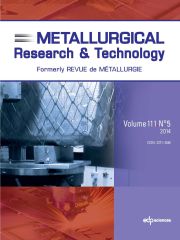Article contents
Investigation on new steel grades for construction of windenergy mills for sustainable energy supply
Published online by Cambridge University Press: 03 June 2014
Abstract
In regard to the sustainability of future cities, an increase in sustainable energysources needs to be managed. Therefore, the German government decided on increasing theratio of green energy up to 20% by 2020. In accordance with this, offshore wind energyparks will be constructed, as they provide the advantage of lasting air cleanliness andpreserving natural resources. To ensure construction safety, wind energy mills areconstructed using ductile steels of large thickness. Here, an application of high-strengthsteels provides the possibility of reducing the amount of material while constructionsafety is still ensured. Considering the long life cycle of wind energy mills’ foundationstructures and the recyclability of the steel grades used, their construction becomes arelevant factor in reducing CO2 emissions. Furthermore, the use of less material reducesCO2 emissions.Due to existing safety concepts, however, the application of high-strength steels is onlyconditionally allowed. Thus, the current study concerns the development of a safetyconcept based on the existing concepts to allow the application of high-strength steels.Furthermore, as the structural steel parts need to be joined, an energy-efficient weldingprocess is utilised: electron beam welding. The structural steel parts and weld joints areinvestigated with respect to their mechanical properties by analysing their loadability incombination with safety concepts. The load on the material is evaluated to ensureconstruction safety. In addition to the investigation of safety requirements, the suppliedmechanical properties are investigated. As the weld joints show different properties fromthe base material, the joints are considered the critical part. The joints areinvestigated concerning strength and toughness. Afterwards the mechanical properties arecorrelated with the wind energy structures. The prevention of failure is fulfilled whenthe mechanical properties of the weld joints exceed the required mechanicalproperties.
Keywords
- Type
- Research Article
- Information
- Metallurgical Research & Technology , Volume 111 , Issue 3: Social Value of Materials (SAM 7) , 2014 , pp. 147 - 153
- Copyright
- © EDP Sciences 2014
References
- 1
- Cited by


